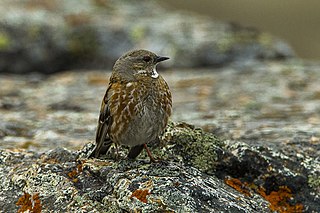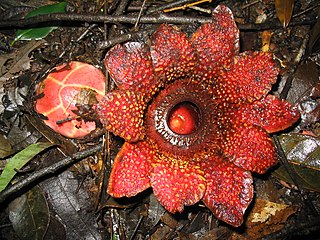
The slaty-headed parakeet is the only psittacid species to exhibit altitudinal migration. The species' range extends from Pakistan, to Western Himalayas in India through Nepal and Bhutan and up to the Eastern Himalayas in the northeastern Indian state of Arunachal Pradesh. They descend to the valleys in winter, approximately during the last week of October.

The Himalayan marmot is a marmot species that inhabits alpine grasslands throughout the Himalayas and on the Tibetan Plateau. It is IUCN Red Listed as Least Concern because of its wide range and possibly large population.

The bar-tailed treecreeper, or the Himalayan treecreeper is a species of bird in the family Certhiidae. It is found primarily in the northern parts of the Indian subcontinent, particularly in the Himalayas, as well as in adjoining regions. It is found in Afghanistan, India, Iran, Kazakhstan, Burma, Nepal, Tibet, Russia, Tajikistan, Turkmenistan, and Uzbekistan. Its natural habitats are boreal forests and temperate forests.

The Altai accentor is a species of bird in the family Prunellidae. It is also known as the rufous-streaked accentor or Himalayan accentor. It breeds in the Altai Mountains of western mongolia; it winters in the southern Tian Shan and Himalayan ranges.

The Himalayan pika is a species of small mammal in the pika family (Ochotonidae). It is found at high altitudes in remote areas of Tibet and possibly also in Nepal. The IUCN has listed this species as being of "least concern".

Sapria himalayana is a rare holoparasitic flowering plant related to Rafflesia found in the Eastern Himalayas. Sapria himalayana represents the extreme manifestation of the parasitic mode, being completely dependent on its host plant for water, nutrients and products of photosynthesis which it sucks through a specialised root system called haustoria. These haustoria are attached to both the xylem and the phloem of the host plant.
Okiseius is a genus of mites in the Phytoseiidae family.
Okiseius alniseius is a species of mite in the family Phytoseiidae.
Okiseius chinensis is a species of mite in the family Phytoseiidae.
Okiseius eharai is a species of mite in the family Phytoseiidae.
Okiseius formosanus is a species of mite in the family Phytoseiidae.
Okiseius juglandis is a species of mite in the family Phytoseiidae.
Okiseius morenoi is a species of mite in the family Phytoseiidae.
Okiseius sikkimensis is a species of mite in the family Phytoseiidae.
Okiseius subtropicus is a species of mite in the family Phytoseiidae.
Okiseius tibetagramins is a species of mite in the family Phytoseiidae.
Okiseius tribulation is a species of mite in the family Phytoseiidae.
Okiseius wongi is a species of mite in the family Phytoseiidae.
Himalayana is a genus of spiders in the family Oonopidae. It was first described in 2014 by Grismado. As of 2017, it contains 6 species from India and Nepal.
Obereopsis himalayana is a species of beetle in the family Cerambycidae. It was described by Stephan von Breuning in 1971.





